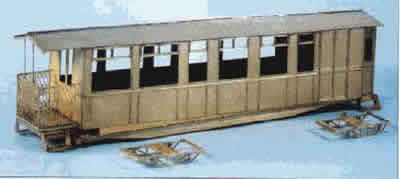



After what seems like a long interval, Worsley Works has recently added the Leek ands Manifold coaches to its range of Scratch Aid etched brass body kits. Both the all third and the brake composite (illustrated) are offered, and they are being sold in pairs.
These vehicles have a distinctly colonial appearance, similar stock was provided for the Barsi Light Railway in India - so could have applications beyond their proper Staffordshire home. It should be noted that these 2'6" gauge coaches are large by 009 standards - they are l72mm (a scale 42'10") long over headstocks, 29mm (7'3') wide and stand 39mm (9'9") above the rail.
As with previous offerings (originally fully reviewed in the November 1997 RM) the kits consist of sides, ends, and floor unit, with separate solebars. To simplify production and keep the cost down, they do not include the interior or glazing, the wheels or any running gear, the couplings, or the fixing nuts and bolts, and there are no 'solid' details as castings. The builder must also supply wire for roof ridge, grab irons and door handles, though the fixing holes are present. For the first time, however. a roof has been included, as it was felt to be essential to protect the fragile balcony ends.
This is the first kit from Worsley Works to have been entirely designed and drawn using a computer, which explains one of the reasons why there has been something of an interval since the last new release: the firm wanted to be sure that it could match the standard of former offerings with the new technology
The components have been very nicely etched - the panelling is well defined and the half-etched areas very even, evidence of quality production techniques
The design envisages the coach body as a box with tie root fixed and a detachable floor, and accordingly stretchers are included as mounts The solebars are separate strips, tabbed so they locate accurately in the floor. When soldering them in place, it is best to start from the centre: it both ends are fixed first, the thin strip may distort with the heat and it wilt be impossible to keep it straight and align the middle
The sides arid ends are separate, with no form of location. but they can be accurately soldered together it care is taken, standing them on a true flat surface. The inset brake end of this coach is also made up of separate panels: it these had been formed as part of the side. to be folded to the appropriate shape, assembly would have been slightly easier.
It is worth reinforcing the corners with a fillet of solder, though take care not to impede the fitting of the floor unit,
The ornate end balcony railings are a superb piece of etching, with the delicate uprights and roof edge board all formed in one piece with the end.
Similarly, the step units are an ingenious design the complex shape folding up from one flat piece.
The instructions are simple and straightforward, adequately the assembly of the components supplied. The kit assumes the builder will have access to drawings and pictures to complete the detailing as appropriate.
The window frames should actually have narrow raised beading, but this would require a third level of etching. The roof edge should have boards along the sides, which can easily be made from brass strip. The small round-edge shelves at floor level where the platform or vestibule are recessed are not present but again these could simply be fabricated. The end beams should be deeper at the centre and tapered towards the side but are flat presumably to allow the fitting of a model coupler which will require more side play than its prototypical counterpart. More seriously, there is no attempt to represent the prominent rivets/bolt heads on the frame and solebars, steps, and so on; if these had been half-etched they could have been pressed out in the traditional manner, but trying this with full thickness material is likely to result in distortion. Also lacking are the brackets on the fame that support the body - accepting the desire to avoid providing castings these might have been made to fold up from etched parts, though they would have been small and fiddly to fit
Perhaps it is not fair to criticise the omissions as these are not supposed to be complete kits, though indicative of how close Worsley Works is now getting to this that the comments do not seem inappropriate! However it relevant to comment on features that could have been designed with little or no extra expense.
Bogies are available as extras - they are very fine etching representing the open bar frame design supplied with brass bearings, and the builder must provide the wheels and fabricate the transverse spring beams and axle box covers The bogie come with mounting bolsters but will need packing for wheel clearance and the correct ride height.
Allen Doherty
19 Douglas Road
Worsley
M28 2SR